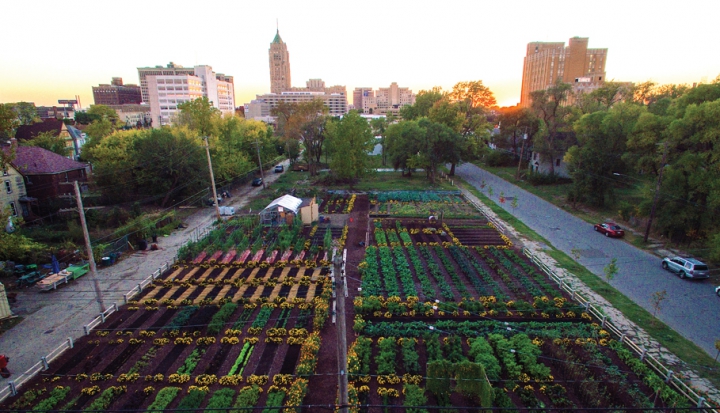“Am I too late?” the young woman asked frantically as she ran into the community center.
The WellnessWorks Mobile Food Pantry was closing for the day, but Deborah Shaffer, regional director for Catholic Charities West Virginia, asked the woman if she needed help.
“She said, ‘Yes, we don’t have any food left in the house, and I haven’t eaten for two days because I wanted to make sure my kids had food,’ ” Shaffer recalls. “I just looked at her and I said, ‘You’ll eat today.’ ”
Every month since 2013 the mobile pantry—a modified 15-passenger van stocked with fresh fruits, vegetables, and whole grains—stops at one of five rural counties in West Virginia. In remote Roane County, some residents have to travel 75 miles round trip through mountain terrain to the nearest grocery store.
But geography isn’t the only barrier to nutritious eating in this part of Appalachia. The White House Task Force on Childhood Obesity found in 2010 that fruit and vegetable prices have increased nearly twice as fast as the price of carbonated drinks. Calorie-dense food with added sugars and fats are often much cheaper and easier to access than fruits and vegetables, many of which also have to be prepared or cooked. In addition, many lower-income families lack adequate transportation. Without cars or the free time to travel to the nearest supermarket, they are forced to rely on convenience stores, fast food, or whatever happens to be in their neighborhood or on their way home from work. With a poverty rate around 18 percent, West Virginia, home of the beleaguered coal mining industry, consistently ranks among the nation’s 10 poorest states, meaning many people face these kinds of barriers to obtaining fresh and nutritious food.
About 2,200 miles away, Catholic Charities Spokane’s Food for All program is tackling a different but fundamentally similar challenge: to boost the nutritional value of the foods eaten in the urban neighborhoods of Spokane, Washington.
Despite serving different cultures, the two organizations have one thing in common: They’re both community-based groups that are striving to increase access to nutritious, affordable food in areas largely populated by those living below the poverty line.
Despite the United States being known for its agricultural bounty, large portions of the country’s population lack access to fruits, vegetables, meats, and dairy. These areas are commonly referred to as “food deserts.” Today the United States Department of Agriculture (USDA) has stopped using the term, replacing it with “low-income and low-access.”
Lack of access to nutritious food is a problem that persists in both rural and urban areas, and in some places the problem has worsened in recent years.
The problem with food access
A study the USDA released in January showed that the number of grocery stores in the United States increased from 2010 to 2015, but because of the Great Recession in the late 2000s, the number of people without vehicles in low-income and low-access areas also increased. These 17.7 million people, comprising about 5.6 percent of the U.S. population, are low-income and live more than a mile from a supermarket in urban areas or 10 miles from a supermarket in rural areas.
The Agricultural Act of 2014, commonly called “the Farm Bill,” authorizes the USDA to spend $125 million a year over five years to offer incentives for grocery stores to open in food deserts. The food choices in such areas is mostly limited to sweet and salty processed foods. While not all processed food is bad for you—canned or frozen vegetables are considered processed, for example—heavily processed foods are often full of additives such as food coloring, sugars, and fats. They are sold in fast food restaurants and in the heavily packaged snacks you find at convenience stores.
Despite the obvious need, food deserts have not seen many new stores from the nation’s largest grocery chains, according to an Associated Press analysis published in March 2016. Of the 10,300 new stores opened by the 75 largest food retailers from 2011 to 2015, only about 250 were in food deserts.
In “Access to Healthier Foods: Opportunities and Challenges for Food Retailers in Underserved Areas,” the Food Marketing Institute cited numerous barriers to entering these areas. Through trial and error, most chains have discovered how to maximize profits in an industry notorious for its tight margins. They don’t want to incur the costs of tailoring those formats to a specific community, which is essential because food tastes and cultures vary so dramatically across the nation. Insurance and security costs are higher in high-crime areas. Recruitment and retention of employees can be difficult in areas with high unemployment. And distribution of customers’ Supplemental Nutrition Assistant Program (SNAP) benefits at the beginning of the month creates cash-flow problems for stores later in the month.
Since 2011 the federal government has spent more than $500 million in incentives to improve access to food stores in underserved areas. But researchers are finding there is more to the problem than opening more stores.
A 2015 study by Ilya Rahkovsky (USDA), Jessie Handbury (the University of Pennsylvania), and Molly Schnell (Princeton University) found that the proximity of fruits, vegetables, and meats had only a minimal effect on people eating those foods. Far more influential on eating habits are taste, affordability, culture, and targeted marketing.
As an example, the article points to a study of two similar Philadelphia neighborhoods, one with a new store and one without, which found that people living in the neighborhood with the store didn’t actually eat more fruits and vegetables.
At the same time the study notes that it doesn’t focus on food deserts. When studying the Detroit neighborhood of Piety Hill, Dave Weatherspoon, a Michigan State University agriculture professor who studies urban food access, found that people there who were introduced to a new store offering fresh fruits and vegetables, after years of lacking one, were just as likely to buy those foods as any consumers.
Healthy food consumption is driven largely by income, price, and knowledge of the nutritious value of fruits and vegetables, Weatherspoon found.
Shaffer, with Catholic Charities West Virginia, also has found that people will eat healthy if they can. When she first started the mobile food pantry, clients would take wheat bread only if the white bread was gone. The wheat bread is more nutrient-rich than white bread but usually costs more, and clients weren’t used to eating it. Now they do the opposite.
“When they find that there are ways that you can still use even inexpensive canned foods and make it healthier, and then supplement it with some fresh fruit when they are able to get it, then they love it,” Shaffer says. “You wouldn’t believe how excited they get over a bag of baby carrots or a head of lettuce.”
Winning them over
Catholic Charities West Virginia (CCWV) recognized that the state’s low population density, high poverty rates, and remote terrain made an influx of new grocery stores highly unlikely. So in 2013, it launched its WellnessWorks Mobile Food Pantry with grants from the Wal-mart Foundation’s Feeding America initiative and the Congregation of St. Joseph.
Shaffer says the first thing she needed to do was identify which of her nine counties needed nutritious food the most. She met with county and state officials, nonprofits, and local pastors.
That was the easy part. Far more challenging was winning the trust of the households in need. Though West Virginia is small, its mountainous geography and lack of convenient highways make travel cumbersome, and each county has a unique culture. Potential clients were initially leery of Shaffer as being from the “big city” of Parkersburg, population 32,000.
But Shaffer’s mother hailed from one of the counties and locals knew the family name, so they quickly embraced her and the pantry.
“You almost have to have an in,” she says. “And it does take time. They want to make sure that we don’t have some sort of ulterior motive, but now they have discovered that the only motive we have is to try and bring good quality food to them.”
Shaffer was surprised to discover how few people in such rural areas grow their own produce. The mobile pantry receives donated and discounted produce from farmers who have a surplus and tries to distribute whole grain foods. It also teaches clients how to eat better, a critical need in a state known for its high rates of cardiac disease and diabetes.
For example, when low-sodium versions of canned vegetables aren’t available, clients are taught how to drain and rinse canned vegetables. Also, each month clients receive a kit with a new healthy recipe, and volunteers prepare the dish and hand out samples.
“When we have only learned to eat certain items and in a certain way, it’s sometimes hard to get people to change their habits,” Shaffer says.
Since the program started tracking statistics in 2014, it has distributed more than 170,000 pounds of food to about 2,000 people. Some of those five counties contain fewer than 5,000 people.
“In our annual surveys, people say, ‘I don’t know what I would do without you,’ ” Shaffer says. “We don’t want them to become too dependent on us. That’s why the education component is so important. But if we can teach them how they can eat better with the same meager amount of money they have available then we’ve been successful.”
Town and country needs
As coordinator of Catholic Charities Spokane’s Food for All program, Jesse Hansen oversees several new initiatives aimed at getting more low-income residents to eat locally grown fruits and vegetables. Poverty in eastern Washington State has grown in recent years with employment declines in the timber, mining, and other extractive industries. The region has some of the state’s most productive farms, but it has taken work to distribute more of their bounty to at-risk households in urban and rural parts of the Spokane area, Hansen says.
Volunteers use two new refrigerated trailers to pull produce grown on area farms to schools and food pantries.
Kids Eating Right – Nutrition and Exercise for Life is a children’s education and activities program for farmers markets. After kids complete an activity, they receive a card that includes information related to the completed activity topic, an easy-to-make recipe, and a $2 voucher for fruits and vegetables.
The program was developed in response to a focus group of women who receive federal Women, Infants, and Children benefits and needed more for their kids to do while they shopped.
“This makes the trip to the farmers market an easier sell for parents to their kids,” Hansen says. “A key component of this program is that it empowers kids to make their own healthy purchasing choices and normalizes buying fresh fruit and vegetables.”
Hansen thinks he’s having the most impact with the organization’s efforts to boost the use of Fresh Bucks, the USDA program that incentivizes SNAP recipients to buy fresh produce. Recipients receive $2 toward the purchase of fruits and vegetables for every $5 they spend at the farmers market.
The Fresh Bucks can be spent only on fresh fruit, vegetables, mushrooms, cut herbs, and seedlings. Customers used more than $33,000 in Fresh Bucks in 2015, five times the $6,500 used in 2012.
Hansen now has 20 farmers markets participating in Fresh Bucks and is talking with six other markets who might sign on in 2017 and 2018.
Rethinking the city
In Detroit, once notorious for its vacant lots and abandoned buildings, about half of the city’s 700,000 residents live in food deserts. Some neighborhoods haven’t seen grocery stores since they were burned down in the 1967 race riots, meaning an entire generation has grown up with little geographic access to fruits and vegetables, says Weatherspoon, the Michigan State professor.
Weatherspoon says access in Detroit has improved moderately over the past few years with the opening of new grocery stores in some areas but nowhere near enough to meet the needs of its lower-income residents.
The nonprofit Michigan Urban Farming Initiative (MUFI) is working to make a difference in the city’s lower North End neighborhood. Founded in 2011 by University of Michigan student Tyson Gersh, the effort has grown from a 30-foot-by-50-foot garden to a one-acre farm growing more than 300 varieties of vegetables on a three-acre campus.
Volunteers grow and harvest the produce, and neighbors can receive as much as they want for free. That amounts to 50,000 pounds of food for 2,000 households over two square miles, with collard greens, okra, and tomatoes being the most popular.
The effort, which the group hopes will become “America’s first sustainable urban agrihood,” is as much about urban redevelopment as improving food access.
“Industrial cities were built for a world and an economy and a lifestyle that don’t exist anymore,” Gersh says, “so we’re at this really interesting stage where we’re trying to redefine what life in the urban environment looks like and how we can repurpose urban infrastructure in a way that can adapt to that. Urban agriculture is an example of what that can look like.”
For example, rather than filling two empty city blocks with single-family homes, cities should devote one of those blocks to green space for farming and build taller residential units on the other block, Gersh says.
Many cities looking for ways to reuse vacant land are hesitant about urban farming because it doesn’t directly produce lucrative economic value. But Gersh says urban farms can spur residential and commercial development. He has measured about $5 million in such impact in the area surrounding the MUFI campus.
About 50 municipalities from as far away as Ireland have contacted the group seeking more information on their model. Melissa Shiner, MUFI volunteer coordinator, hopes to see it spread elsewhere.
Shiner encourages nonprofits and municipalities elsewhere not to be intimidated by urban farming and not to underestimate its potential to address food access problems. The more households see urban farms in their neighborhoods, the more likely they are to grow gardens in their own yards, Shiner says.
Faith in action
Although she sometimes feels overwhelmed by the sheer amount of poverty in rural West Virginia, Shaffer knows she is living her Christian faith through her work. She points to Matthew 25:44–45, when Jesus’ disciples asked him when they had ever seen him hungry and not fed him, and he answered, “What you did not do for one of these least ones, you did not do for me.”
In Washington state, Catholic bishops in November also cite Matthew 25 in their pastoral letter, “Who Is My Neighbor?: The Face of Poverty in Washington State.” After listening sessions with people living in poverty, the bishops called on the state’s Catholics and governmental entities to do more to help the poor with food, shelter, and employment.
“As Catholics, we have a moral obligation to inform our consciences in light of Scripture and Catholic teaching, and then to take direct action that demonstrates concern for our sisters and brothers,” states the letter, signed by the archbishop of Seattle, bishop of Spokane, bishop of Yakima, and auxiliary bishop of Seattle.
Speaking about hunger during a radio address in October, Pope Francis called on Catholics to “respond personally to concrete situations of need in our own lives.”
“Saint James warns against ignoring the practical needs of our brothers and sisters, for faith without works is dead,” the pope said. “In the miracle of the loaves and fishes, Jesus tells his disciples to provide food for the crowds, yet he shows them that in sharing what they have, he will give them increase.”
The Catholic Church around the country is heeding the call of Pope Francis and the U.S. bishops, not just by bringing food to low-access neighborhoods but also by empowering residents to learn more about the food they consume.
“You’d be shocked by how many people want to eat healthier food, who want to eat broccoli instead of Cheetos,” Shiner says. “There’s a misconception in food deserts that people don’t want to eat healthy. They do, but they just don’t have a market to go to.”
This article also appears in the June 2017 issue of U.S. Catholic (Vol. 82, No. 6, pages 12–17).
Image: Courtesy of the Michigan Urban Farming Initiative














Add comment